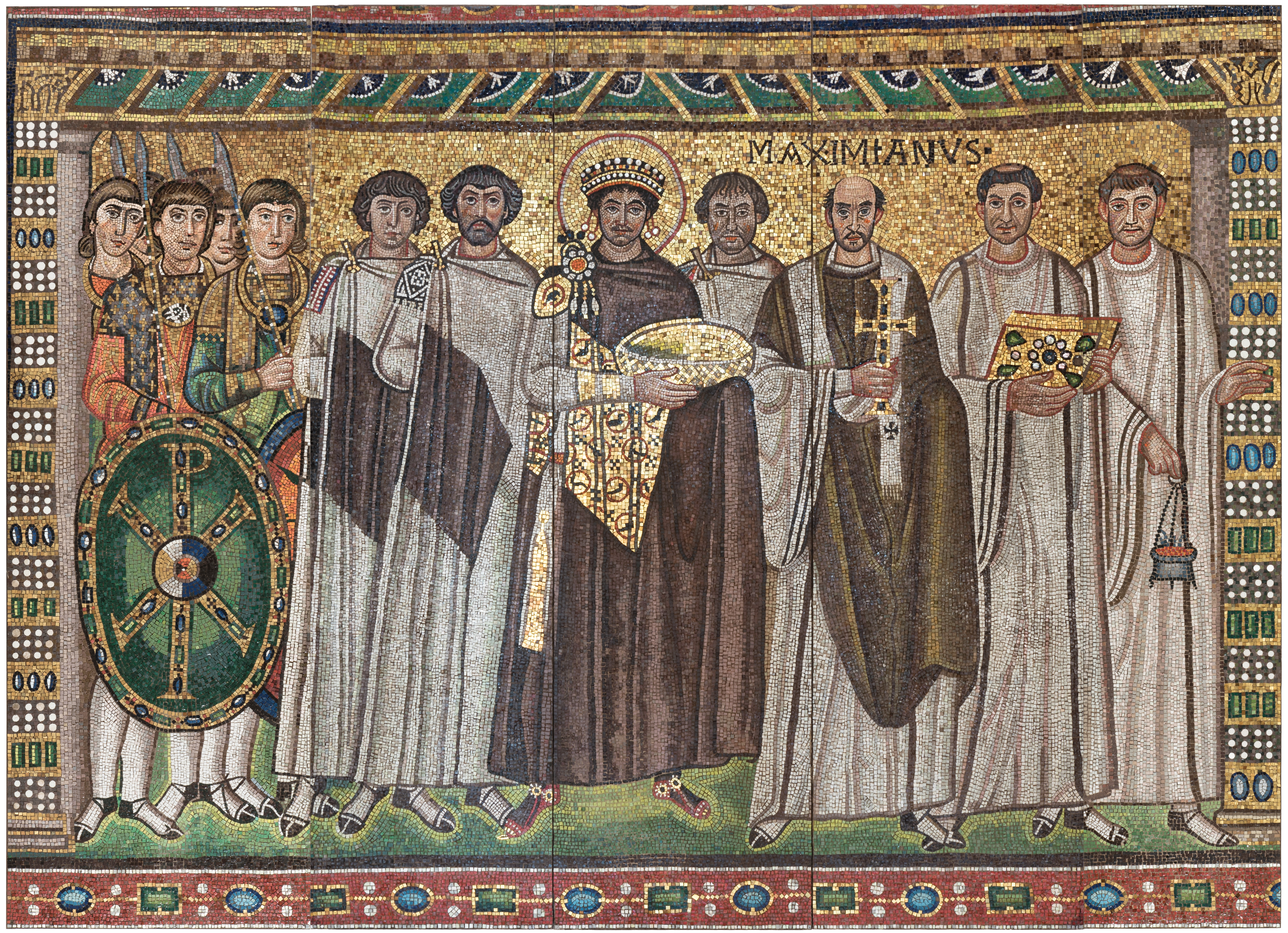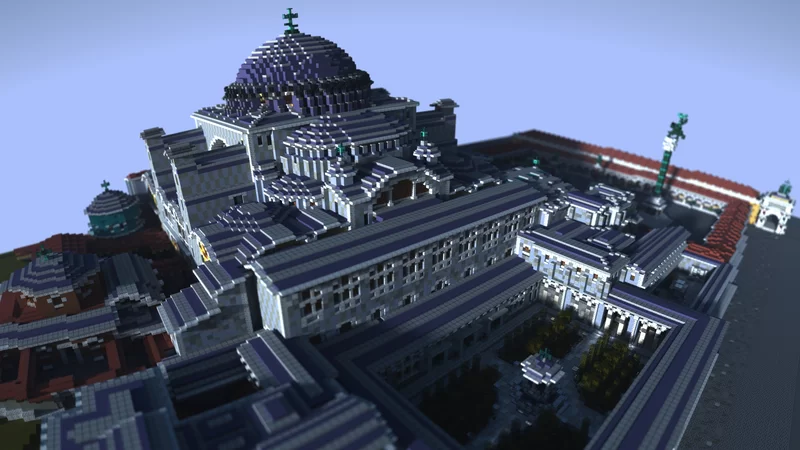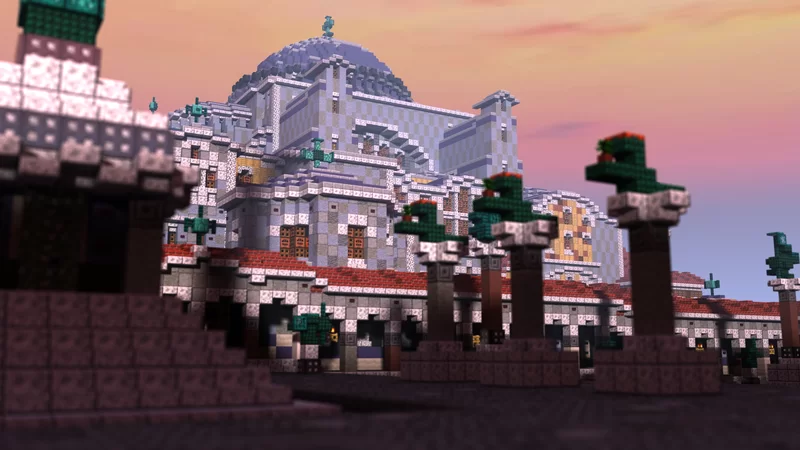- 12,524 views, 20 today
- 1,413 downloads, 1 today
161
Hagia Sophia
Merry Christmas!
This is my second, much improved and (hopefully) final iteration of the Hagia Sophia as part of my greater (and ongoing) Constantinople project. This is a 1:1 scale (1 block=1 meter) reconstruction of the Great Church as it may have looked around 1200 A.D. This new and improved version comes complete with the whole episcopal complex of the Great Church, as well as the monumental Augustaion square. This time around there won't be a schematic, as I have packed the church with all its documented and historically accurate mosaics which have long since disappeared.
History of the Hagia Sophia
History

Emperor Justinian and His Court, Ravenna, c. 547 A.D
The Hagia Sophia we know today was constructed in 537 A.D on the orders of Roman Emperor Justinian, however its history goes back further.
When the capital of the Roman Empire was transferred from Rome to Constantinople in 330 A.D, the new imperial capital needed a suitable place of worship. Emperor Constantius II chose the current site of Hagia Sophia for the construction of a great Christian Basilica. Little is known about this first iteration of the church, although it was presumably a wooden-roofed basilica church similar to Old St. Peter's Basilica in Rome.
Constantius' ambitions were not to be, as a mere 4 decades later the church was burned during a religious riot. The damage was so severe that Emperor Theodosius II had to rebuild it from scratch. This second church was fronted by a grand marble portico decorated with sculptures of crosses and sheep. It was to this church that the Skeuophylakion (treasury) of the Great Church was added, which still remains today.
This church too, would meet the same fate as its predecessor. In 532 the new Emperor of Rome, Justinian was almost overthrown during the Nika Riot in the center of Constantinople. The rioters burned down large chunks of the city center and among the fires victims was the Great Church. Justinian, thanks to the resilience of his wife (Empress Theodora) was eventually able to crush the riot and retain his throne, but the damage had been done.
Seeking a building which would monumentalize the city center, legitimize his rule and illustrate his piousness, the Emperor sought the best architects of the time to rebuilt the ruined church. Isidore of Miletus and Anthemius of Tralles both designed the third, and current church on the site. The new church had a revolutionary design, combining the rectangular plan of a basilica, with a domed central plan of a mausoleum. When the new church was finally consecrated in 537, the witnesses could scarcely believe whether they were on heaven or on earth. Emperor Justinian for his part, did nothing less than to proclaim:
"Solomon, I have surpassed thee"
The new church would not be without problems however. In 558 the main dome collapsed and Justinian had to oversee its reconstruction. The decoration inside the church was also not complete and would not be fully embellished until the reign of his successor, Emperor Justin II.
The Great Church would serve as the main cathedral of Constantinople, seat of the Patriarch of Constantinople and the religious centerpiece of the Roman Empire. This religious importance would often surround the building with great tension. In 726 Emperor Leo III issued an edict forbidding the use of religious images. All depictions of saints, Jesus and the Virgin Mary were defaced and removed from the church during this time. Only in 842 would this vandalism come to and end, and the restoration of icons was celebrated in the church by Emperor Michael III and Patriarch Photios, while a brand new mosaic of the Virgin Mary looked on from the apse.
This celebration was short lived, as the western part of the church's dome and the western half-dome collapsed in 869. Emperor Basil I ordered immediate repairs be made. Basil made the windows of the church smaller, but further embellished it by adding new mosaics in the nave depicting Patriarchs, saints and biblical figures.
Another earthquake in 989 A.D caused further damage, and Emperor Basil II ordered further repairs, as well as adding even further mosaic decoration to the church.
By 1000 A.D the Hagia Sophia was the largest and greatest church in all of Christendom. It impressed travelers far and wide, and its influence could be seen from the deserts of Arabia, to the snowy tundras of Russia. Its unmatched beauty was so great that ambassadors from the Kievan Rus urged the Russian Prince to convert to Orthodox Christianity, as a religion that housed such an awe inspiring temple had to be the only true and virtuous faith.
The story of Hagia Sophia does not end here. But its subsequent history is outside the scope of this build.
Contents of the Build
Contents of the build
This build contains the entire Episcopal Complex of the Hagia Sophia as it may have been in Byzantine times. The following buildings/structures are included:
-Hagia Sophia
-Augustaion Square + Column of Justinian
-Patriarchal Palace
-Thomiates
-Baptistery
-Metatorion
-Big Baptistery
-Skeuophylakion
-Chapel of the Holy Well
-Passage of St. Nicholas
-Chapel of St. Nicholas
-Hagia Sophia
-Augustaion Square + Column of Justinian
-Patriarchal Palace
-Thomiates
-Baptistery
-Metatorion
-Big Baptistery
-Skeuophylakion
-Chapel of the Holy Well
-Passage of St. Nicholas
-Chapel of St. Nicholas
Bibliography
Bibliography
The following books/articles were used in the research and construction of this build.
-"Hagia Sophia In Context", Ken Dark, 2019
-"Mosaics of Hagia Sophia, Istanbul: The Fossati Restoration and the Work of the Byzantine Institute",
Natalia B. Teteriatnikov, 1998
-"The Mosaics of St. Sophia at Istanbul", Cyril Mango, 1972
-"The Art of the Byzantine Empire", Cyril Mango. 1986
-"The Patriarchal Palace at Constantinople in the seventh century:", Ken Dark/Jan Kostenec, 2014
-"Russian Pilgrims in Constantinople, George Majeska, 2002
-"Byzantine Court Culture from 829 to 1204. 1997
-"The Book of Ceremonies", 10th Century, English translation by Ann Moffatt and Maxeme Tall, 2012
-"Hagia Sophia In Context", Ken Dark, 2019
-"Mosaics of Hagia Sophia, Istanbul: The Fossati Restoration and the Work of the Byzantine Institute",
Natalia B. Teteriatnikov, 1998
-"The Mosaics of St. Sophia at Istanbul", Cyril Mango, 1972
-"The Art of the Byzantine Empire", Cyril Mango. 1986
-"The Patriarchal Palace at Constantinople in the seventh century:", Ken Dark/Jan Kostenec, 2014
-"Russian Pilgrims in Constantinople, George Majeska, 2002
-"Byzantine Court Culture from 829 to 1204. 1997
-"The Book of Ceremonies", 10th Century, English translation by Ann Moffatt and Maxeme Tall, 2012
Stay tuned for more updates on Constantinople in the (hopefully) near future!
Merry Christmas and a Happy New Year!
| Progress | 100% complete |
| Tags |
1 Update Logs
Update #1 : by marvelfannumber2 02/21/2023 8:00:08 pmFeb 21st, 2023
Made many changes to the build to increase accuracy. Map has also been updated to 1.17, allowing me to increase the quality of the build with new blocks.
Enjoy a preview of these changes in the form of an immersive walking tour added to the post :)
Enjoy a preview of these changes in the form of an immersive walking tour added to the post :)
tools/tracking
5419016
2
hagia-sophia-the-great-church




































![Roma Aeterna (w/ Download Link!) [mc 1.10.2]](https://static.planetminecraft.com/files/resource_media/screenshot/1331/small/Fori_3638331_thumb.jpg)






Create an account or sign in to comment.
I just need to update a few mosaics and I should be good. Expect a much belated update sometime this weekend.
By the time period I depicted it in, it should honestly be more of a oxidized copper-like color, but I couldn't find any good blocks for that exact color. So I just decided to go with the original gray marble, which clay is the closest to.
I've literally just made an account on Planet Minecraft to congratulate you for this awesome (in the sense of awe-inspiring too) build. It's by far the best rendition of the Hagia Sophia I have seen, especially because of the attention to detail and due to the fact that you also researched and included its adjacent buildings. Let me be 100% honest with you: the moment I loaded into the map, standing in the portico of the Augustaion looking at the magnificent floating dome of the Hagia Sophia, I admit I got emotional. I have been a Byzantinophile for about fifteen years or more by now. My interest in Byzantine studies led me to pursue a BA in History after I had completed my first college undergraduate course. If being a historian was financially viable in the context of my country, you can bet I would have become a proper Byzantinist myself.
That is all to say: the moment I stepped into your build it felt like I was actually stepping into Constantinople for the first time ever, fully immersed in a realized 3D environment. So, congratulations on your achievement and thank you for building and sharing this. I eagerly await to hear from you and your Project Byzantium in the future.
Now, I have a question: is it possible to open this file in Conquest Reforged? I'd like to play around with it in singleplayer and would love to use some Conquest blocks.
Secondly, recently I have also done in depth research into the topography of the Great Palace, because I, even despite the poor Minecrafter I am, would also like to try my hand at bringing the Great Palace back to life, starting from Boukoleon. I've consulted authors such as Bardill, Bolognesi, Featherstone, Westbrook etc. and my annotations document is ever expanding. It's such a complex set of details and mysteries. How could the Justinianos connect to the northern end of the Lausiakos and be directly accessible from the Tripeton at the same time? What was immediately to the west of the Tripeton itself (I wonder, could it have been the Mouchrotas/Manoeulites, despite being a much later addition to the complex?)? Were the kiosks of Theophilus north or south of the Kainourgios, uphill or attached to the Koiton by the sea wall? Where on Earth was the Phiale of the Blues, if it's a place that could both be seen from the terrace of the Chrysotriklinos and used to board barges? If the Pharos was adjacent to the Monumental Staircase, how do you fit the Phiale in there, considering the Pharos would take the space between the 16 m (or 11 m) terrace and the building attached to the loggia? What happened to the Phiale of the Greens anyway? What in Justinian's name was the Thermastra, and how did it fit between the Lausiakos and the Apsis? How could the lantern of the Pharos be seen from a window in Our Lady of the Pharos if the church was to the south of the Chrysotriklinos and the Pharos was by the entrance of the staircase? How could a person make their way directly from the Justinianos to the Theotokos without crossing the Chrysotriklinos or entering the imperial gallery? Was there perhaps a passage from the Tripeton going beneath the Kainourgios and opening to a possible atrium of the church serving as a closed courtyard of the Koiton? What was the exact course of Nikephoros II's wall, and what buildings were demolished to make way for it? Was the Kathisma included, after all? There are so many questions, and the problem isn't the dearth of answers. On the contrary, it's that there are too many answers for the same questions.
Anyway, if you would like to share and compare notes, I'd be very grateful. Hit me up on Discord, perhaps we can help each other.